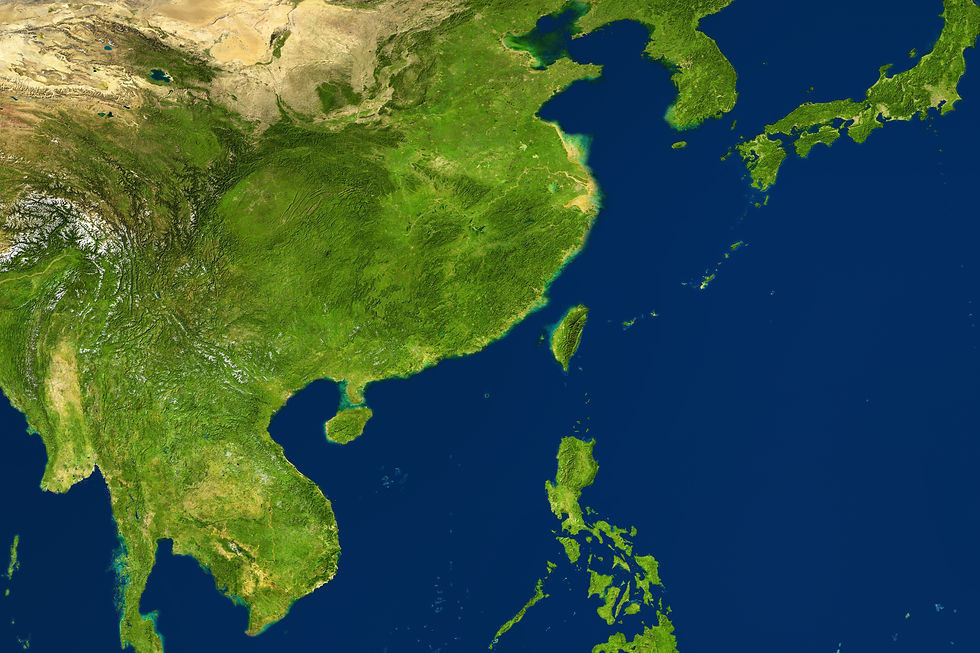Rising Tensions: The Military Buildup in Asia’s Strategic Waters
- Mondial Logistics
- Jun 12
- 4 min read
Updated: Aug 8

Asia is becoming one of the most heavily watched regions in the world—and not just
because of its booming economies or cultural influence. There’s something else
happening beneath the headlines: a quiet but steady military buildup, especially in
Southeast Asia and along what’s known as the First Island Chain.
This growing concentration of forces is raising concerns about stability, security, and the potential for conflict in one of the world’s busiest and most important regions.
What Is the First Island Chain?
The First Island Chain refers to a string of islands stretching from Japan and Taiwan,
down through the Philippines, and into the West Philippines Sea. These islands sit at the edge of the western Pacific Ocean and act as a natural barrier between mainland China and the open Pacific.
Because of its strategic location, the First Island Chain is central to military
planning—especially for the United States, China, and regional powers. Control of this
zone means greater influence over trade routes, airspace, and naval movement.
Why the Buildup?
There are a few reasons why we’re seeing increased military activity in this region:
1. China’s Rise: Over the past two decades, China has rapidly expanded and
modernized its military. It has built military bases on artificial islands in the West Philippines Sea, increased naval patrols, and regularly sends aircraft near Taiwan. China views much of the First Island Chain as a natural extension of its sphere of influence.
2. US and Allied Response: The United States and its allies—like Japan, Australia, and
the Philippines—have responded with their own military presence. The U.S. Navy
regularly conducts “freedom of navigation” operations to challenge what it sees as excessive Chinese claims. New defense agreements and joint military exercises have become more frequent.
3. Regional Tensions: Several countries in Southeast Asia—like Vietnam, the
Philippines, and Indonesia—are also strengthening their forces. These nations are
concerned about protecting their territory, fishing rights, and undersea resources from foreign encroachment, particularly in disputed waters.
Why It Matters.
This isn’t just a regional issue. The trade routes through Southeast Asia carry about one-third of global shipping traffic and holds rich oil, gas, and fishing resources. Any
disruption—military or otherwise—will affect the global economy.
There’s also the risk of accidents or miscalculations. When multiple militaries operate in close quarters, even a small incident—like a collision between ships or planes—can
escalate into something much more serious.
Why Western Companies Are Becoming Involved.
With tensions rising and operational requirements growing, the Indo-Pacific is becoming a priority region for defense logistics and infrastructure investment.
Western defense and logistics companies have a major role to play—not only to support their national governments and allies but also to contribute to regional stability.
Opportunities include:
- Forward-deployed logistics hubs to support multi-domain operations.
- Expeditionary infrastructure development, such as runways, ports, and storage facilities.
- Supply chain solutions for remote island and coastal operations.
- Secure communications, cyber infrastructure, and base support services.
- Disaster response logistics in climate-vulnerable regions.
As militaries increase their footprint in the region, there is a critical need for reliable,
scalable, and regionally integrated logistics support. Companies that can offer dual-use capabilities—supporting both defense and humanitarian missions—are particularly well-positioned.
Why is the Philippines an Ideal Strategic Hub for Southeast Asia?
Among Southeast Asian nations, the Philippines is uniquely positioned to serve as the
operational nerve center for defense, logistics, and maritime strategy in the region for a number of reasons:
- Geographic Location: Sitting at the crossroads of the South China Sea and the
Philippine Sea, the Philippines is at the heart of the First Island Chain. Its location makes it a vital staging area for any regional military or logistics operation—within striking distance of key maritime chokepoints and contested waters.
- Allied Partnerships: As a major non-NATO ally of the United States and a strong
participant in multilateral defense exercises (such as Balikatan), the Philippines is a
trusted partner in regional security efforts. The 2023 expansion of the U.S.
Philippines Enhanced Defense Cooperation Agreement (EDCA) has only strengthened this strategic alignment.
- Existing Infrastructure: Legacy U.S. military facilities—such as those in Subic Bay and Clark—offer deep-water ports, airfields, and logistics corridors that can be revitalized for modern operations. These areas are already being eyed by defense and logistics providers for long-term investments.
- English Proficiency and Workforce Readiness: The Philippines has one of the most English-proficient and logistics-capable workforces in Asia. Its experience in global shipping, business process outsourcing, and maritime operations makes it ideal for technical training, coordination, and international engagement.
- Economic Growth and Incentives: With ongoing reforms in investment policy, freeport zones, and defense-industrial cooperation, the Philippines is actively encouraging foreign companies to set up logistics, manufacturing, and support hubs—especially in sectors that bolster national resilience.
Looking Ahead
The military buildup in Southeast Asia and the First Island Chain is part of a larger shift in global power dynamics. As nations compete for influence and security, the region is becoming more militarized—and potentially more volatile.
The challenge is to balance strength with diplomacy, readiness with restraint, and
economic growth with stability. For both governments and businesses, the Indo-Pacific Region is no longer a future concern—it’s a defining issue of the present.




Comments